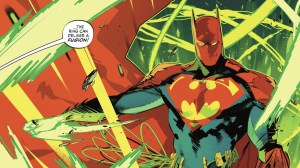In a matter of days, NASA will share the first images captured by the James Webb Space Telescope, one of the most elaborate vessels ever sent to space. In the meantime, the space agency is celebrating the holiday weekend by releasing snapshots from Webb’s predecessor, the Hubble Space Telescope.
Videos by ComicBook.com
That includes a stunning snapshot of a nearby galaxy pushing waves of cosmic dust through space. According to one of the latest Instagram posts on NASA’s account, the picture is of the Tarantula Nebula, a section of the Large Magellanic Cloud (LMC), a neighboring galaxy to our own Milky Way.
“Traditionally, images of the LMC aren’t so tranquil. For this image @NASAHubble researchers substituted the lens filter which selects red light and replaced it with a filter letting through near-infrared light,” NASA’s post reads. “The result: the dominant hydrogen gasses which typically present an image brimming in hues of pink are replaced by other less prominent emission lines encompassing shades of blue and green.”
An image like this then helps the space agency interpret and develop other similar pictures using newfound data and processes.
“Unique data such as this helps shed new light on our understanding of the cosmos,” the post adds. “This data is part of a project that gathered together and processed over 1,000 images taken using the Hubble telescope. This collection of data is used to study a wide range of astronomical topics, from gravitational lensing, which is how the gravity of massive galactic objects bends light, to exploring and studying the creation of stars in distant galaxies.”
While the above image was taking by Hubble, NASA administrator Bill Nelson previously confirmed the Webb Telescope will return images of the deepest parts of space researchers have yet to visit.
“If you think about that, this is farther than humanity has ever moved before,” Nelson said at a press conference last month. “And we’re only beginning to understand what Webb can and will do. It’s going to explore objects in the solar system and atmospheres of exoplanets orbiting other stars, giving us clues as to whether potentially their atmospheres are similar to our own.”








